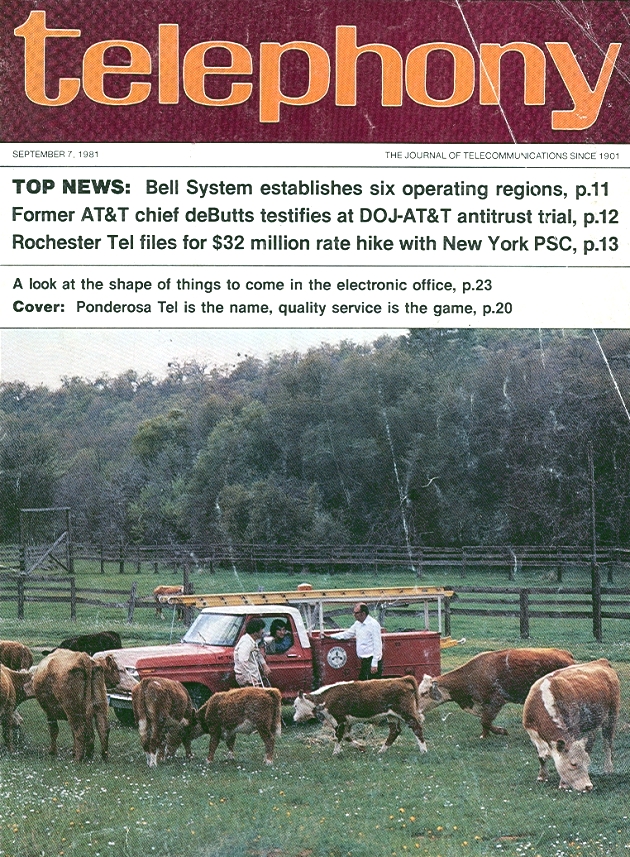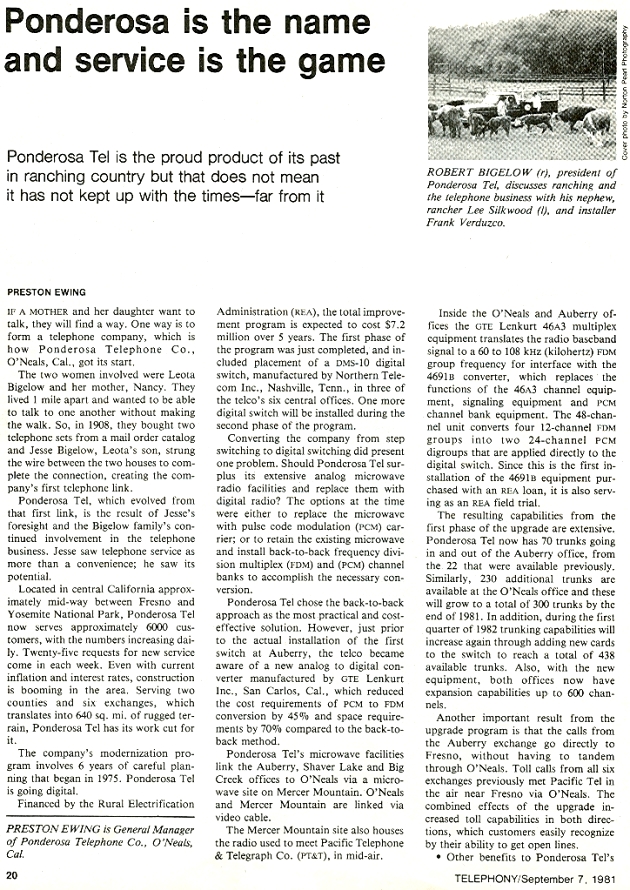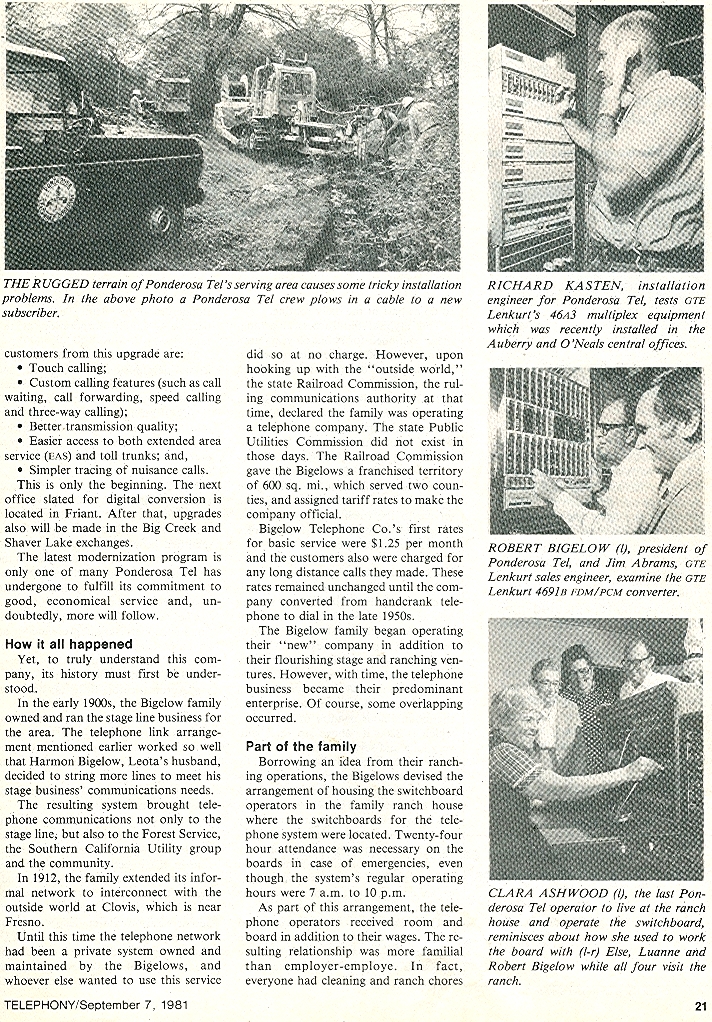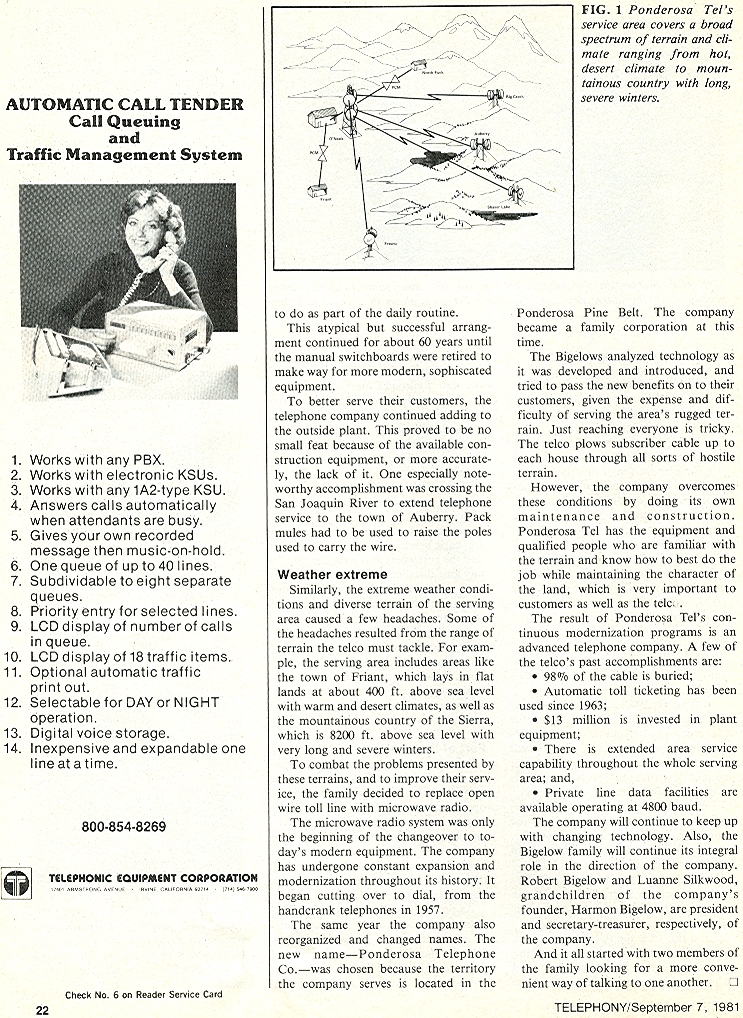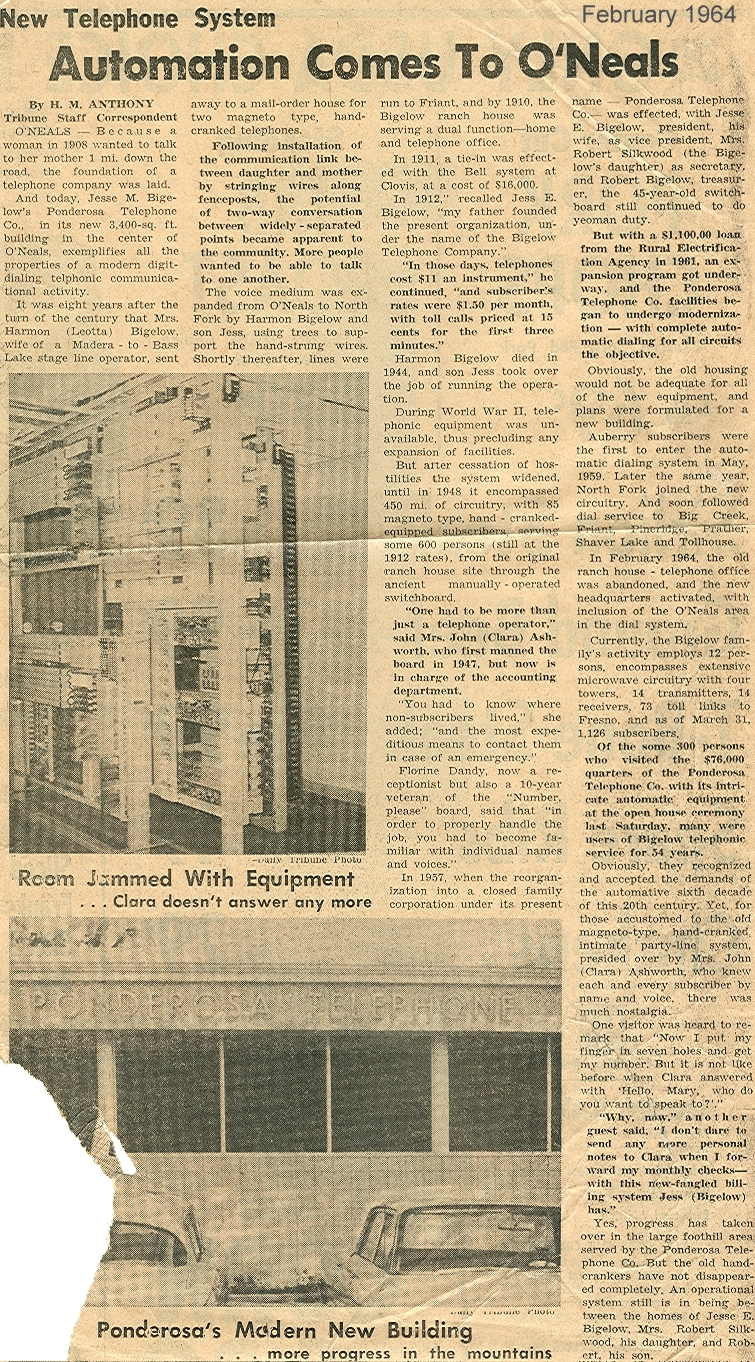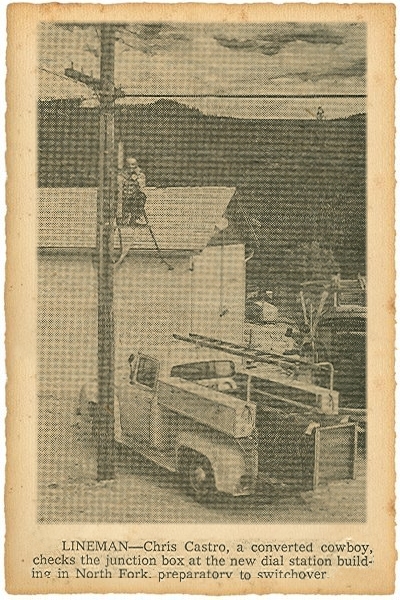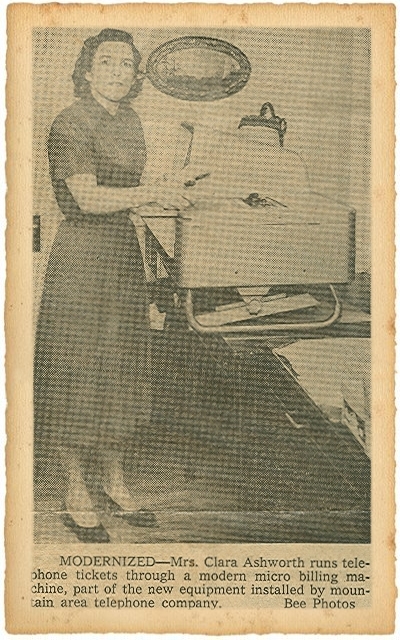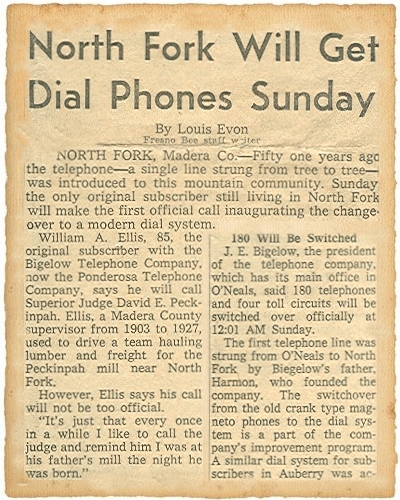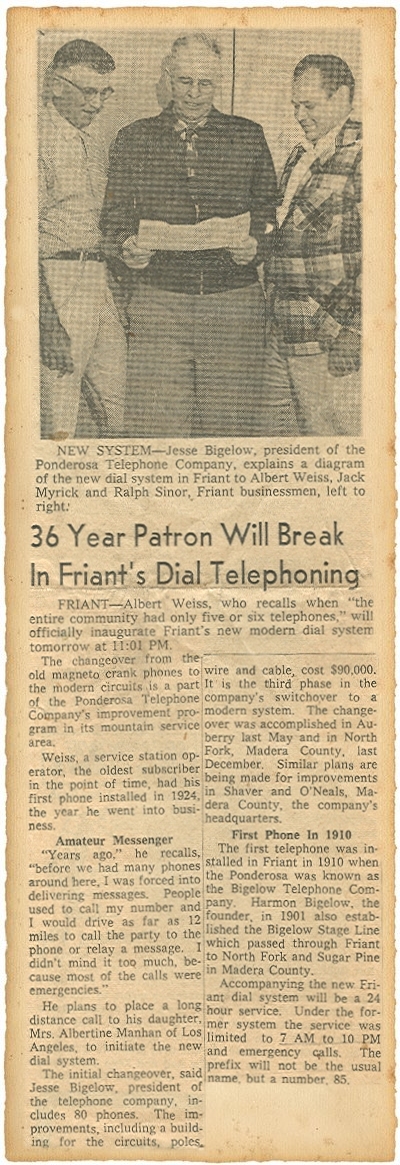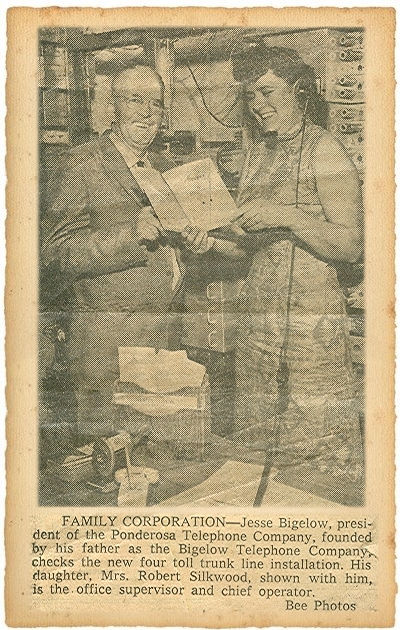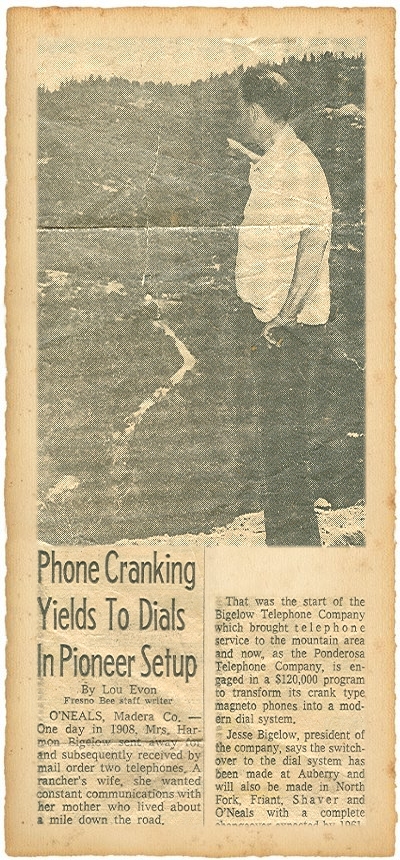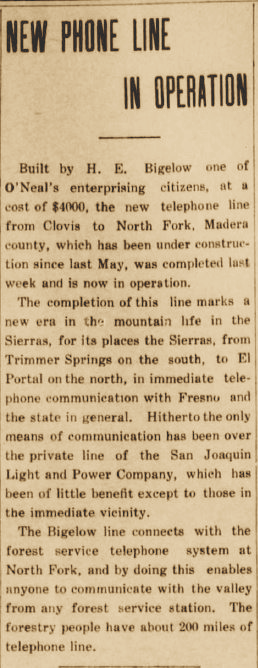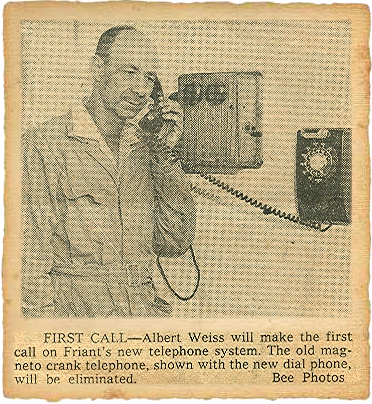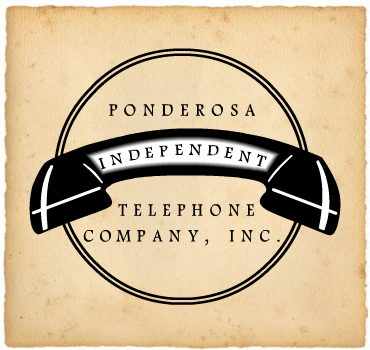Article displayed with permission by Telephony magazine.
Transcription
Cover
Telephony
The Journal of Telecommunications Since 1901
September 7, 1981
Top News
Bell System establishes six operating regions, p. 11
Former AT&T chief deButts testifies at DOJ-AT&T antitrust trial, p.12
Rochester Tel files for $32 million rate hike with New York PSC, p.13
A look at the shape of things to come in the electronic office, p.23
Cover: Ponderosa Tel is the name, quality service is the game, p.20
Cover photo description: In the foreground, a red truck with a ladder is parked in a cow run, which is filled with green grass and dotted with orange and white wildflowers. The truck is marked with the Ponderosa Tel logo. One person is sitting in the driver’s seat of the truck, and two people are leaning against it. They are surrounded by cows. A brown fence delineates another corral behind the truck, this one empty. A dense line of oak trees is just beyond the farthest fence in the background.
Image captions
- ROBERT BIGELOW, (r), president of Ponderosa Tel, discusses ranching and the telephone business with his nephew, rancher Lee Silkwood, (l), and installer Frank Verduzco.
Cover photo by Norton Pearl Photography. - THE RUGGED terrain of Ponderosa Tel’s serving area causes some tricky installation problems. In the above photo a Ponderosa Tel crew plows in a cable to a new subscriber.
- RICHARD KASTEN, installation engineer for Ponderosa Tel, tests GTE Lenkurt’s 46^3 multiplex equipment which was recently installed in the Auberry and O’Neals central offices.
- ROBERT BIGELOW, (r), president of Ponderosa Tel, and Jim Abrams, GTE sales engineer, examine the GTE Lenkurt 4691B FDM/PCM converter.
- CLARA ASHWORTH (l), the last Ponderosa Tel operator to live at the ranch house and operate the switchboard, reminisces about how she used to work the board with (l-r) Else, Luanne, and Robert Bigelow while all four visit the ranch.
- FIG. 1: Ponderosa Tel’s service area covers a broad spectrum of terrain and climate ranging from hot, desert climate to mountainous country with long, severe winters.
Article
Ponderosa is the name and service is the game
Ponderosa Tel is the proud product of its past in ranching country but that does not mean it has not kept up with the times – far from it
by Preston Ewing
If a mother and her daughter want to talk, they will find a way. One way is to form a telephone company, which is how Ponderosa Telephone Co., O’Neals, Cal., got its start.
The two women involved were Leota Bigelow and her mother, Nancy. They lived 1 mile apart and wanted to be able to talk to one another without making the walk. So, in 1908, they bought two telephone sets from a mail order catalog and Jesse Bigelow, Leota’s son, strung the wire between the two houses to complete the connection, creating the company’s first telephone link.
Ponderosa Tel, which evolved from that first link, is the result of Jesse’s foresight and the Bigelow family’s continued involvement in the telephone business. Jesse saw telephone service as more than a convenience; he saw its potential.
Located in central California approximately mid-way between Fresno and Yosemite National Park, Ponderosa Tel now serves approximately 6000 customers, with the numbers increasing daily. Twenty-five requests for new service come in each week. Even with current inflation and interest rates, construction is booming in the area. Serving two conties and six exchanges, which translates into 640 sq. mi. of rugged terrain, Ponderosa Tel has its work cut out for it.
The company’s modernization program involves 6 years of careful planning that began in 1975. Ponderosa Tel is going digital.
Financed by the Rural Electrification Administration (REA), the total improvement program is expected to cost $7.2 million over 5 years. The first phase of the program was just completed, and included placement of a DMS-10 digital switch, manufactured by Northern Telecom Inc., Nashville, Tenn., in three of the telco’s six central offices. One more digital switch will be installed during the second phase of the program.
Converting the company from step switching to digital switching did present one problem. Should Ponderosa Tel surplus its extensive analog microwave radio facilities and replace them with digital radio?The options at the time were either to replace the microwave with pulse code modulation (PCM) carrier; or to retain the existing microwave and install back-to-back frequency division multiplex (FDM) and (PCM) channel banks to accomplish the necessary conversion.
Ponderosa Tel chose the back-to-back approach as the most pracitcal and cost-effective solution. However, just prior to the actual installation of the first switch at Auberry, the telco became aware of a new analog to digital converter manufactured by GTE Lenkurt Inc., San Carlos, Cal., which reduced the cost requirements of PCM to FDM converstion by 45% and space requirements by 70% compared to the back-to-back method.
Ponderosa Tel’s microwave facilities link the Auberry, Shaver Lake and Big Creek offices to O’Neals via a microwave site on Mercer Mountain. O’Neals and Mercer Mountain are linked via video cable.
The Mercer Mountain site also houses the radio used to meet Pacific Telephone & Telegraph Co. (PT&T), in mid-air.
Inside the O’Neals and Auberry offices the GTE Lenkurt 46^3 multiplex equipment translates the radio baseband signal to a 60 to 108 kHz (kilohertz) FDM group frequency for interface with the 4691B converter, which replaces the functions of the 46^3 channel equipment, signaling equipment, and PCM channel bank equipment. The 48-channel unit converts four 12-channel FDM groups into two 24-channel OCM digroups that are applied directly to the digital switch. Since this is the first installation of the 4691B equipment purchased with an REA loan, it is also serving as an REA field trial. The resulting capabilities from the first phase of the upgrade are extensive. Ponderosa Tel now has 70 trunks going in and out of the Auberry office, from the 22 that were available previously. Similarly, 230 additional trunks are available at the O’Neals office and these will grow to a total of 300 trunks by the end of 1981. In addition, during the first quarter of 1982 trunking capabilities will increase again through adding new cards to the switch to reach a total of 438 available trunks. Also, with the new equipment, both offices now have expansion capabilities up to 600 channels.
Another important result from the upgrade program is that the calls from the Auberry exchange go directly to Fresno, without having to tandem through O’Neals. Toll calls from all six exchanges previously met Pacific Tel in the air near Fresno via O’Neals. The combined effects of the upgrade increased toll capabilities in both directions, which customers easily recognize by their ability to get open lines.
Other benefits to Ponderosa Tel’s customers from this upgrade are:
- Touch calling;
- Custom calling features (such as call waiting, call forwarding, speed calling and three-way calling);
- Better-transmission quality;
- Easier access to both extended area service (EAS) and toll trunks; and,
- Simpler tracing of nuisance calls.
This is only the beginning. The next office slated for digital conversion is located in Friant. After that, upgrades also will be made in the Big Creek and Shaver Lake exchanges.
The latest modernization program is only one of many Ponderosa Tel has undergone to fulfill its commitment to good, economical service and, undoubtedly, more will follow.
How it all happened
Yet, to truly understand this company, its history must first be understood.
In the early 1900s, the Bigelow family owned and ran the stage line business for the area. The telephone link arrangement mentioned earlier worked so well that Harmon Bigelow, Leota’s husband, decided to string more lines to meet his stage business’ communications needs.
The resulting systerm brought telephone communications not only to the stage line, but also to the Forest Service, the Southern California Utility group and the community.
In 1912, the family extended its informal network to interconnect with the outside world at Clovis, which is near Fresno.
Until this time the telephone network had been a private system owned and maintained by the Bigelows, and whoever else wanted to use this service did so at no charge. However, upon hooking up with the “outside world,” the state Railroad Commissions, the ruling communications authority at that time, declared the family was operating a telephone company. The state Public Utilities Commission did not exist in those dats. The Railroad Commission gave the 600 sq. mi., which served two counties, and assigned tariff rates to make the company official.
Bigelow Telephone Co.’s first rates for basic service were $1.25 per month and the customers also were charged for any long distance calls they made. These rates remained unchanged until the company converted from handcrank telephone to dial in the late 1950s.
The Bigelow family began operating their “new” company in addition to their flourishing stage and ranching ventures. However, with time, the telephone business became their predominant enterprise. Of course, some overlapping occurred.
Part of the family
Borrowing an idea from their ranching operations, the Bigelows devised the arrangement of housing the switchboard operators in the family ranch house where the switchboards for the telephone system were located. Twenty-four hour attendance was necessary on the boards in case of emergencies, even though the system’s regular operating were 7 a.m. to 10 p.m.
As part of this arrangement, the telephone operators received room and board in addition to their wages. The resulting relationship was more familial than employer-employee. In fact, everyone had cleaning and ranch chores to do as part of the daily routine.
This atypical but successful arrangement continued for about 60 years until the manual switchboards were retired to make way for more modern, sophisticated equipment.
To better serve their customers, the telephone company continued adding to the outside plant. This proved to be no small feat because of the available construction equipment, or more accurately the lack of it. One especially note-worthy accomplishment was crossing the San Joaquin River to extend telephone service to the town of Auberry. Pack mules had to be used to raise the poles used to carry the wire.
Weather extreme
Similarly, the extreme weather conditions and diverse terrain of the serving area caused a few headaches. Some of the headaches resulted from the range of terrain the telco must tackle. For example, the serving area includes areas like the town of Friant, which lays in flat lands at about 400 ft. above sea level with warm and desert climates, as well as the mountainous country of the sierra, which is 8200 ft. above sea level with very long and severe winters.
To combat the problems presented by these terrains, and to improve their service, the family decided to replace open wire toll line with microwave radio. The microwave radio system was only the beginning of the changeover to today’s modern equipment. The company has undergone constant expansion and modernization throughout its history. It began cutting over to dial, from the handcrank telehpones in 1957.
The same year the company also reorganized and changed names. The new name – Ponderosa Telephone Co. – was chosen because the territory the company serves is located in the Ponderosa Pine Belt. The company became a family corporation at this time.
The Bigelows analyzed technology as it was developed and introduced, and tried to pass the new benefits on to their customers, given the expense and difficult of serving the area’s rugged terrain. Just raching everyone is tricky. The telco plows subscriber cable up to each house through all sorts of hostile terrain.
However, the company overcomes these conditions by doing its own maintenance and construction. Ponderosa Tel has the equipment and qualified people who are familiar with the terrain and know how to best do the job while maintaining the character of the land, which is very important to customers as well as the telco.
The result of Ponderosa Tel’s continuous modernization programs is an advanced telephone company. A few of the telco’s past accomplishments are:
- 98% of the cable is buried;
- Automatic toll ticketing has been used since 1963;
- $13 million is invested in plant equipment;
- There is extended area service capability throughout the whole serving area; and,
- Private line data facilities are available operating at 4800 baud.
The company will continue to keep up with changing technology. Also, the Bigelow family will continue its integral role in the direction of the company. Robert Bigelow and Luanne Silkwood, grandchildren of the company’s founder, Harmon Bigelow, are president and secretary-treasurer, respectively, of the company.
And it all started with two members of the family looking for a more convenient way of talking to one another.
Prestion Ewing is General Manager of Ponderosa Telephone Co., O’Neals, Cal.

